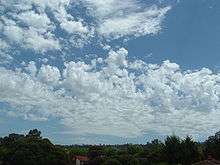Altocumulus castellanus cloud
| Altocumulus castellanus | |
|---|---|
 Altocumulus castellanus clouds | |
| Abbreviation | Ac, ACCAS |
| Genus | Altocumulus (high, heaped) |
| Species | castellanus (castle) |
| Altitude |
2,000 - 6,000 m (6,500 - 20,000 ft) |
| Classification | Family B (Medium-level) |
| Precipitation cloud? | No, but could signify later precipitation. |
Altocumulus Castellanus (ACCAS) is named for its tower-like projections that billow upwards from the base of the cloud. The base of the cloud can form as low as 2,000 metres (6,500 feet), or as high as 6,000 metres (20,000 feet), or 3296 Nm. They are very similar to cumulus congestus clouds, but at a higher level.
Castellanus clouds are evidence of mid-atmospheric instability and a high mid-altitude lapse rate.[1] They may be a harbinger of heavy showers and thunderstorms and, if surface-based convection can connect to the mid-tropospheric unstable layer, continued development of Castellanus clouds can produce cumulonimbus clouds.
Altocumulus Castellanus clouds are typically accompanied by moderate turbulence as well as potential icing conditions. For these reasons, flight through Altocumulus Castellanus clouds is often best avoided by aircraft. [2]
The appearance of Altocumulus Castellanus early in a sunny day may indicate a high probability the formation of thunderstorms in the afternoon, as they may develop into cumulonimbus storm clouds. [3]
References
- ↑ "weather.com - Glossary". Archived from the original on 7 December 2008. Retrieved 2008-12-06.
- ↑ "Weather Tutorial Page 4c - Clouds (NASA Quest)". Retrieved 2008-12-06.
- ↑ "Clouds". Aeronautics Learning Laboratory for Science Technology, and Research. Archived from the original on 21 December 2008. Retrieved 2008-11-27.